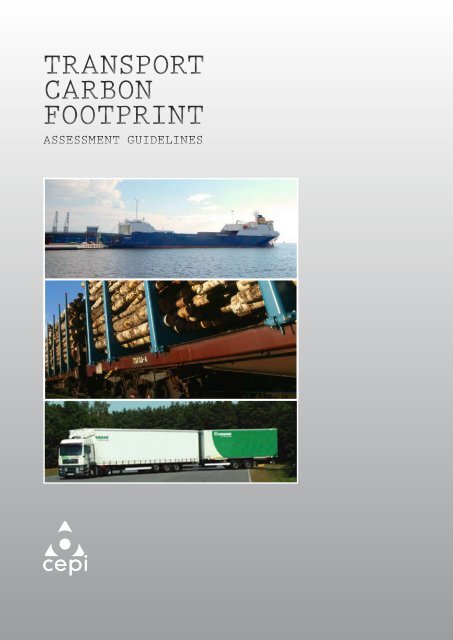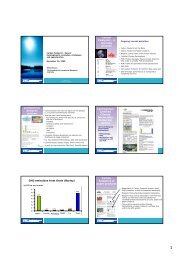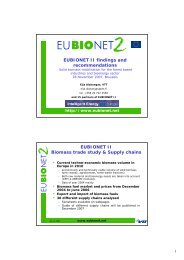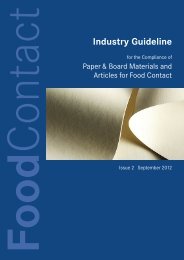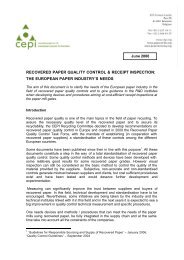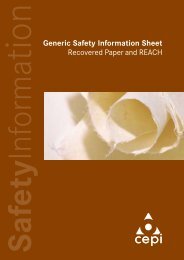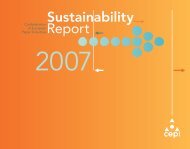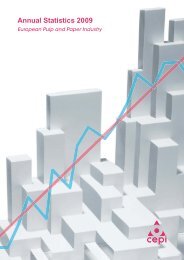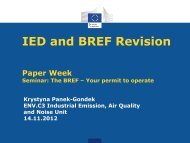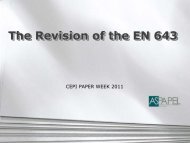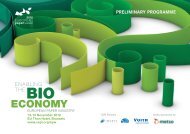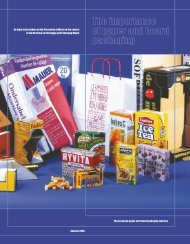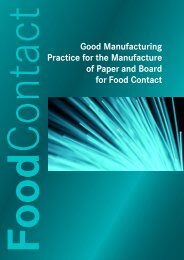Transport Carbon Footprint - Assessment Guidelines - CEPI ...
Transport Carbon Footprint - Assessment Guidelines - CEPI ...
Transport Carbon Footprint - Assessment Guidelines - CEPI ...
You also want an ePaper? Increase the reach of your titles
YUMPU automatically turns print PDFs into web optimized ePapers that Google loves.
Table of ContentBackground ....................................................................................................................................................................... 4I. Introduction....................................................................................................................................................................... 4II. Direct greenhouse gases related to transport .................................................................................. 5III. Cut-off criteria and system boundaries ................................................................................................... 6III.1 Raw material supply - Items 1, 2, 3 and 4 .................................................................................. 7III.2 Product delivery - Items 5 and 6 ...................................................................................................... 8III.3 Waste disposal - Item 7 ............................................................................................................................. 9IV. Measuring and estimating transport-related emissions ......................................................... 10Annexe A: the 10 Toes of the <strong>Carbon</strong> <strong>Footprint</strong> Framework ................................................ 11Annexe B: <strong>CEPI</strong>PRINT - <strong>CEPI</strong>FINE diagram ................................................................................................ 12Annexe C: Databases ............................................................................................................................................ 13<strong>CEPI</strong>, December 2009.3
BackgroundThe aim of these guidelines is to help the European pulp and paper companies in assessing theshare of their products’ carbon footprint related to transport in a harmonised way. These guidelinesshould allow companies to deliver a transparent and credible assessment. The work, carried out bythe <strong>CEPI</strong> <strong>Transport</strong>ation Network, should be considered as a contribution and a complement to the<strong>CEPI</strong> ‘Framework for the development of <strong>Carbon</strong> <strong>Footprint</strong>s for Paper and Board Products’, released inSeptember 2007.I. IntroductionAs described in the <strong>CEPI</strong> Framework, Toe 7 1 includes: greenhouse gas emissions (GHG)associated withtransporting raw materials, products and waste along the value chain. It includes all emissions fromtransporting wood, recovered fibre, other raw materials, intermediate products, final products and usedproducts as well as manufacturing residuals.Regarding transport fuel, CO 2emissions from the combustion of biofuels are not considered tocontribute to global warming as the carbon that is released balances the carbon that has been takenup from the atmosphere by the growing plants. However emissions from crop growth, e.g. N 2O fromfertilisation of crops, and from the production of biofuels, e.g. with use of fossil fuels, contribute toglobal warming.1. See Annex A. Toe 7 does NOT include:- CO 2 emissions from burning biomass and the use of biofuels (included as additional information and may be used to characterisesequestration along the value chain as discussed in Appendix F of the <strong>CEPI</strong> <strong>Carbon</strong> <strong>Footprint</strong> Framework - Annex F:Characterising the effect of forests, biomass fuels and forest products on the atmosphere) ;- Emissions associated with growing and harvesting wood and with processing mixed waste to produce recovered paper(included in Toe 4).4
II. Direct greenhouse gasesrelated to transportFossil CO 2(carbon dioxide), CH 4(methane) and N 2O (nitrous oxide) emissions represent about 98% ofthe total GHG emissions related to transport 2 .<strong>Carbon</strong> footprint assessment for transport focus mainly on CO 2emissions from fossil fuels as CH 4andN 2O emissions are normally much lower than CO 2emissions related to fossil fuel combustion.<strong>CEPI</strong> recommendations• <strong>Carbon</strong> footprint assessment must focus in priority where the largest emissions related totransport happen, particularly on CO 2emissions from fossil fuels.Optional• Mills/companies are encouraged to assess the impact of other gases if they exceed the cut-offcriteria and are needed to satisfy the intended use of the footprint.2. Other emissions related to transport such as SO 2, NO xand CO contribute to other environmental impacts (e.g. acidification,eutrophication) and are not considered here.5
III.1 Raw material supplyItems 1, 2, 3 and 4Raw materials include fibres (wood and recovered paper mainly) or even pulp for non-integratedpapermakers and other input such as pigments, fillers and chemicals. <strong>Transport</strong> packaging toaccompany and protect paper deliveries might also be considered as input; its supply to the mills alsohas an impact on transport emissions, but proportion is relatively limited. Fuels are supplied to the millsby all kinds of transport or by pipes.The amounts of wood fibre transported through the upstream portions of the value chain are muchlarger than for other raw materials, so in many cases it may be possible to limit the calculations toemissions associated with the transport of virgin fibre and recovered fibre.In some cases, particularly recovered paper, it might be difficult to identify the exact source or origin.Traceability is a determining factor as far as raw materials are concerned. Suppliers can be asked aboutthe carbon footprint of the raw materials they sell to mills.For pigments and chemicals, the amounts transported and the transport distances can be ofsignificance in some cases, depending on the pulp and paper grades.<strong>CEPI</strong> recommendations• Emissions associated with the transport of fibres have to be focused on as a priority.• Raw materials that are used with a volume equal to or more than 10kg for the production of1 tonne of pulp/paper - 1% ratio - should be included. 90% of the total volume of raw materialsused must be covered. All fibrous materials must be covered.• <strong>Transport</strong> of raw materials must not be allocated only to pulp or paper production if amill produces other products. Only the transport of wood to be used for pulp or papermanufacturing or energy production related to the pulp or paper manufacturing must beallocated to pup or paper production; the transport of wood used to produce biofuel to besold or electricity to be sold to the grid should be allocated to this sold energy. There aredifferent ways to allocate raw materials’ transport: according to MWh, tonnes, cubic metres oreconomic value. The allocation methodology should however be clearly explained.• The emissions from all fuels that imply physical transport from the purchasing place to themill gate must be included.• When the result of the carbon footprint assessment related to transport is to be used orcombined together with that of the other Toes, there must be no double counting, because e.g.transport data may be included in CO 2factors for pulp in database or suppliers’ footprints.Optional• <strong>Transport</strong> should reflect, as much as possible and traceable, the real situation. Companiescould consider transport emissions from the production source rather than the purchasingplace if traceability allows it. Assumptions on transport to the purchasing place might beneeded if suppliers cannot deliver the information.7
Annex AThe 10 Toes of the <strong>Carbon</strong> <strong>Footprint</strong> FrameworkThe 10 Toes of the <strong>Carbon</strong> <strong>Footprint</strong> as described in the <strong>CEPI</strong> Framework are:• Toe 1 - <strong>Carbon</strong> sequestration in forests• Toe 2 - <strong>Carbon</strong> in forest products• Toe 3 - Greenhouse gas emissions from forest product manufacturing facilities• Toe 4 - Greenhouse gas emissions associated with producing fibre• Toe 5 - Greenhouse gas emissions associated with producing other raw materials and fuels• Toe 6 - Greenhouse gas emissions associated with purchased electricity, steam and heat• Toe 7 - <strong>Transport</strong>-related greenhouse gas emissions• Toe 8 - Emissions associated with product use• Toe 9 - Emissions associated with product end-of-life• Toe 10 - Avoided emissions Extract from the <strong>CEPI</strong> “Framework for the development of <strong>Carbon</strong> <strong>Footprint</strong>s for Paper and Board Products”,September 2007.11
Annex B<strong>CEPI</strong>PRINT-<strong>CEPI</strong>FINE diagramBoundaries and processes included in the modelExtract from the <strong>CEPI</strong>PRINT AND <strong>CEPI</strong>FINE’S USER GUIDE TO THE CARBON FOOTPRINT, 2008.12


